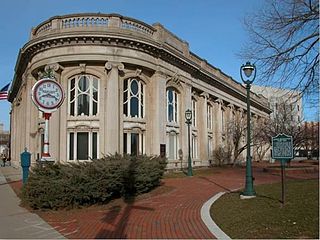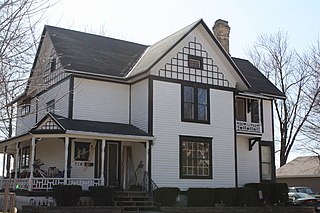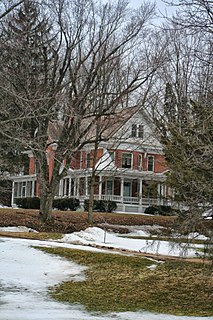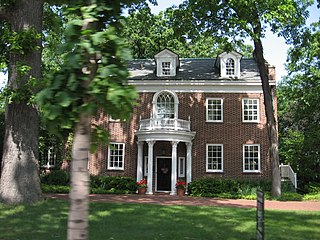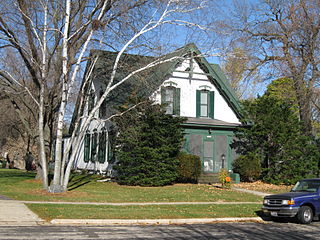Merritt Black House | |
 | |
| Location | 104 River Rd. Kaukauna, Wisconsin |
|---|---|
| Coordinates | 44°17′10″N88°16′40″W / 44.28611°N 88.27778°W Coordinates: 44°17′10″N88°16′40″W / 44.28611°N 88.27778°W |
| Built | 1898 |
| Architectural style | Queen Anne |
| NRHP reference # | 84003752 |
| Added to NRHP | March 29, 1984 |
The Merritt Black House is a historic house built in 1898 along the Fox River in Kaukauna, Wisconsin. In 1984 it was listed on the National Register of Historic Places. [1]

Kaukauna is a city in Outagamie and Calumet counties, Wisconsin, United States. It is situated on the Fox River, approximately 100 miles (160 km) north of Milwaukee. The population was 15,462 at the 2010 census. It is a part of the Appleton, Wisconsin Metropolitan Statistical Area.

The National Register of Historic Places (NRHP) is the United States federal government's official list of districts, sites, buildings, structures, and objects deemed worthy of preservation for their historical significance. A property listed in the National Register, or located within a National Register Historic District, may qualify for tax incentives derived from the total value of expenses incurred preserving the property.
The two-story house was built in 1898 in the Queen Anne style of architecture. The exterior walls are of rusticated stone cut from a local quarry operated by Merritt Black himself. The stone is a bit unusual for Queen Anne, but the varied surface finishes, the bay windows, the 3-story corner tower, the asymmetry, and the complex roof are all typical of the style. If the shape of the house looks a bit abrupt for Queen Anne, it may be because it originally had broad porches wrapping around several sides, which have been removed. Inside are oak doors and stairs and maple floors. In the basement are rooms for vegetable and fruit storage. The house was designed by the Smith brothers of Appleton. The carpenter was Gus Keck, the mason Joseph Schwenderman, and the painter Walter Cuel. [2] [3]

The Queen Anne style in Britain refers to either the English Baroque architectural style approximately of the reign of Queen Anne, or a revived form that was popular in the last quarter of the 19th century and the early decades of the 20th century. In British architecture the term is mostly used of domestic buildings up to the size of a manor house, and usually designed elegantly but simply by local builders or architects, rather than the grand palaces of noble magnates. Contrary to the American usage of the term, it is characterised by strongly bilateral symmetry with an Italianate or Palladian-derived pediment on the front formal elevation.

A bay window is a window space projecting outward from the main walls of a building and forming a bay in a room.

A bricklayer, which is related to but different from a mason, is a craftsman who lays bricks to construct brickwork. The terms also refer to personnel who use blocks to construct blockwork walls and other forms of masonry. In British and Australian English, a bricklayer is colloquially known as a "brickie". A stone mason is one who lays any combination of stones, cinder blocks, and bricks in construction of building walls and other works. The main difference between a bricklayer and a true mason is skill level: bricklaying is a part of masonry and considered to be a "lower" form of masonry, whereas stonemasonry is a specialist occupation involved in the cutting and shaping of stones and stonework.
Merritt Black's father Andrew was born in Ohio and came to Wisconsin in 1846. He bought hundreds of acres in north Kaukauna and began to farm, and to speculate in farmlands. J. Merritt, the youngest surviving son, helped his father farm and operated a stone quarry. In 1898 he built the house described above. He later drilled wells, farmed and worked as a realtor. After J. Merritt died, his son Merritt A. lived in the house, working in real estate and insurance. The house was known as the Black Castle. [3]


